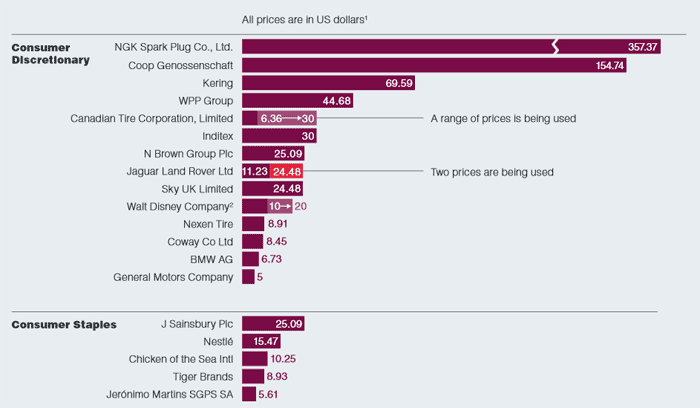The UK's Carbon Disclosure Project (CDP) is out with its latest report on the use of internal carbon pricing in business, and it finds use of the practice has risen dramatically in the past year as companies prepare for whatever comes out of the UN climate meeting in Paris in December.
The CDP annually surveys its 1000 plus corporate members on the use of carbon pricing internally. This year, 437 companies globally said they were doing so, versus 150 in 2014. In the US and Canada, the total number of companies pricing carbon more than doubled to 97 this year.
The biggest jump in the use of carbon pricing comes from Asian corporations, which saw more than a tenfold increase, exploding from 8 in 2014 to 93 this year.
The GreenSupplyChain.com notes that it is not clear how much of these increases in the numbers are reflected of companies truly going from not using carbon pricing to doing so, versus just more companies responding to the survey, but nevertheless is seems likely indicative of a real trend.
For example, this year's survey asked whether companies that are not currently using an internal price on carbon anticipate doing so in the next two years. An additional 583 firms said Yes to that question.
The data "signals a pivot point: Climate change is now part of mainstream business decision-making and represents a bona-fide line item in the standard budget assumptions of successful companies," CDP says. "As expectation builds for governments to agree a global deal on limiting greenhouse gas (GHG) emissions in Paris this December, the CDP data shows how a growing number of businesses have been diligently preparing by incorporating a price on these emissions into their everyday decision making."
Of course, whether there will be a real price for carbon emissions coming sometime after the UN meeting is an unknown, though odds seem to favor an agreement of some kind. But will the agreement be voluntary, or in some fashion legally binding like a treaty (and thus require Senate approval)? Either way, how will the effective price for C02 emissions be set?
These are huge questions for the parameters around which supply chains will have to operate in the coming years.
The CDP report includes comments on the issue from a number of companies around the globe. Below, for example, is an excerpt from US industrial company Owens Corning:
""For use in internal decision-making and risk analysis, we place an economic value on carbon emissions to help frame the challenges and opportunities in monetary, more broadly understood terms than simply tons of emissions," the company said through the survey. "Quantifying these added costs, in the event that a price is put on carbon in regions around the world where a current price or trading scheme is not in place, provides additional insight into our business decisions. We bracket this analysis, on the low end at $10/metric ton and a high of $60/metric ton."
The Owens Corning statement raises several important issues. First, the company is not directly using a price for CO2 emissions in its decision-making, but is modelling those costs to provide some insight into what a non-free CO2 emissions world might look like financially. Some refer to this as "carbon shadow pricing."
Second, in doing that it is using a very broad range of potential costs, from a low of $10 to as high as $60 per metric ton – quite a gap from low to high.
Here is what consumer packaged goods giant Colgate-Palmolive had to say:
"In support of our 2020 Sustainability Climate goal of reducing absolute CO2 emissions from our global factories by 25%, Colgate purchases appropriate quantities of green power in the form of green-e certified US-based Renewable Energy Certificates (RECs)," the company says. "The cost of this green power purchase is then internally charged back to our global sites directly in proportion to their emissions. Although the REC costs are relatively modest compared to energy costs, we believe this sends yet another important financial signal to our sites, and further incentivize them to consider the potential opportunities associated with reducing their carbon emissions."
So in Colgate's case, it is using a form of carbon costs, but one which is relatively low compared to a different regulatory structure might bring, such as a direct carbon tax.
In fact, the vast preponderance of the report comes from are snippets of such comments made in the survey from companies across the globe.
The prices or price ranges being used by a sample of companies in a couple of consumer goods related sectors is shown below. All prices are in US dollars per metric ton of CO2 emissions.

Source: Carbon Disclosure Project
Note again the extremely wide range of prices used by companies, from just $5.00 per ton by GM to as much as $357 dollars by Japan's NGK Spark Plus Co. (which seems a tad high to us).
Regardless, the full CDP report is available here: Putting a price on risk: Carbon pricing in the corporate world
Is your conpany using carbon pricing? In any real way, or just to see the potential impact on decisions? Why is the range of prices so wide? Let us know your thoughts at the Feedback button below.

|